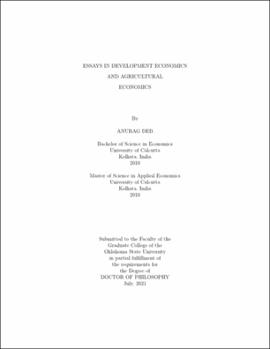| dc.contributor.advisor | Kazianga, Harounan | |
| dc.contributor.author | Deb, Anurag | |
| dc.date.accessioned | 2022-01-21T19:20:09Z | |
| dc.date.available | 2022-01-21T19:20:09Z | |
| dc.date.issued | 2021-07 | |
| dc.identifier.uri | https://hdl.handle.net/11244/333789 | |
| dc.description.abstract | We study the impact of the Kenyan Tea Liberalization program on educational attainment in the Tea growing areas of Kenya. Tea is a major cash crop in Kenya and tea expansion is likely to generate more returns for female labors as females have a comparative advantage in tea cultivation. Following the literature on intra-household allocation we test if this increase in tea production causes improvement in education attainment of children. We compare the tea producing regions with other non-producing regions by applying a simple DID process to estimate an the Treat effect of the of exposure to tea harvesting. The education completion rate shows that the treatment has a positive effect on the treated cohort. However, there is no treatment effect on female labor participation rate for the females. Our results are robust across the specifications and different samples. In Chapter 2, we estimate the effects of increased exposure to agricultural technologies on farmers' adoption and economic wellbeing in Ghana, Mali, and Senegal using post-implementation data collected in 2019. The program, known as the West Africa Agricultural Productivity Program (WAAPP), aimed at improving agricultural productivity to enhance economic growth, food security and to reduce poverty reduction and ran in two phases. We focus on the second phase of the program, which ran between 2012 and 2019. We use ex-ante matching at the village and household levels to select the estimation sample. We find that households participating in the program have a 32% higher probability of adopting agricultural technologies and are 19% more likely to use improved seeds. The program also increases the productivity and incomes of the treated households by 4% and 29%, respectively. There were no detectable effects on consumption and food security. We provide suggestive evidence indicating that the additional income may have been saved or invested. Taken together, these results suggest that multi-country agricultural programs can be effective at spurring economic transformation. In Chapter 3, we consider the Factories Act 1948 that mandates all recognized manufacturing units need to register their factories and are subject to government regulation, maintain proper work environment and abide by labor regulations. In our paper we use two data sets, for the registered sample we use the Annual Survey of India (ASI) and the National Sample Survey of Un-incorporated Non-agricultural Enterprises. Our estimates show that Registered factories have higher production per worker and have significantly higher salary for the workers. | |
| dc.format | application/pdf | |
| dc.language | en_US | |
| dc.rights | Copyright is held by the author who has granted the Oklahoma State University Library the non-exclusive right to share this material in its institutional repository. Contact Digital Library Services at lib-dls@okstate.edu or 405-744-9161 for the permission policy on the use, reproduction or distribution of this material. | |
| dc.title | Essays in development economics and agricultural economics | |
| dc.contributor.committeeMember | Azam, Mehtabul | |
| dc.contributor.committeeMember | Adkins, Lee | |
| dc.contributor.committeeMember | Nyantakyi, Eugene Bempong | |
| osu.filename | Deb_okstate_0664D_17379.pdf | |
| osu.accesstype | Open Access | |
| dc.type.genre | Dissertation | |
| dc.type.material | Text | |
| thesis.degree.discipline | Economics | |
| thesis.degree.grantor | Oklahoma State University | |
